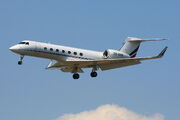Business jets, also known as corporate jets, are small aircraft. Their passenger capacity is usually limited to ten people, enough for a few passengers, their baggage, and a small crew. Their interiors are often luxurious, contrasting strongly with the cramped cabins of airliners. Refreshments would most likely be tailored to the clients, rather than being predetermined.
Most corporate jets have two or three engines, mounted towards the tail to reduce noise. Take, for example, this jet, a Gulfstream G550. The twin engines are mounted aft, whereas the engines of a airliner would have the engines in pods underneath the wings.

A Gulfstream G550 approaching Frankfurt Airport
Other differences between business jets and regular airplanes include how they're boarded/exited. Usually, a stream of passengers proceeds down a Jetway (you know, those gray things that stick out of an airport terminal) to board the aircraft. With business jets, though, the plane is simply out on the tarmac, distanced from the airport and with no Jetway. The passengers walk up the step installed on the inside of the boarding door. In the picture of the G550, you can see this door, located just behind the cockpit and just before the cabin windows. The passengers descend through this same door on their way out.
Also, business jets are very expensive. Even big companies often can only get timeshares, where they pay a certain amount of money (thousands of dollars) to use the jet for a certain amount of time. Being able to own such a jet in full indicates great wealth. If the clients consume refereshments-- champagne, wine, French dishes, etc.-- that may cost money, too, while the average air commuter already has his food and drink included in the ticket price.
Classes[]
Very light jets[]
Very light jets (VLJ), also called entry-level or personal jets,typically seat 4-8 passengers. They often have a MTOW under 10,000 lbs (4,540 kg), and are approved for single-pilot operation. They have relatively low operating costs, and can operate from runways as short as 3,000 ft (910 m). As they are used for very short flights, many have no or limited restroom facilities.
- Cirrus SF50
- Eclipse 550
- Phenom 100EV
- Nextant 400XTi
- Citation M2
- HondaJet
Light jets[]
Light jets provide access to small airports and typically accomodate 6-8 passengers over a 1,953 nmi range
- Beechcraft Premier
- Cessna CitationJet/CJ1/2/3
- Cessna Citation II/Brave/Ultra/Encore
- Hawker 400
- Learjet 31
- Learjet 40
- Embraer Phenom 300
- SyberJet SJ30i
- Learjet 70
Mid-size jets[]
Mid-size jets are suitable for transcontinental flights, and can accommodate about 9-12 passengers.
- Citation Excel/XLS(+)
- Hawker 800/750/850/900/1000
- Learjet 45
- Learjet 60
- Learjet 75
- Legacy 450
Super mid-size jets[]
Super mid-size jets feature wide-body cabin space, long range, high speed, and high-altitude capability. They can accommodate about 10-19 passengers over a 3282 nmi range.
- Cessna Citation X
- Cessna Citation Sovereign
- Bombardier Challenger 300/350
- Dassault Falcon 50
- Gulfstream G200/G250
- Hawker 4000
- Embraer Legacy 500
- Gulfstream G280
Large jets[]
Large business jets typically accommodate 13-19 passengers over a 4001 nmi average range. Long range large jets have a 6419 nmi average range.
- Bombardier Challenger 600
- Dassault Falcon 2000(ER)
- Dassault Falcon 900
- Embraer Legacy 600/650
- Gulfstream 500
VIP airliners[]
Airliners converted into business jets are typically the most expensive type of private jet. They often face operational restrictions based on runway length or noise mitigation, but they provide greater space capabilities than smaller business jets.